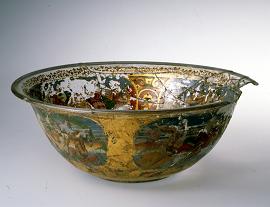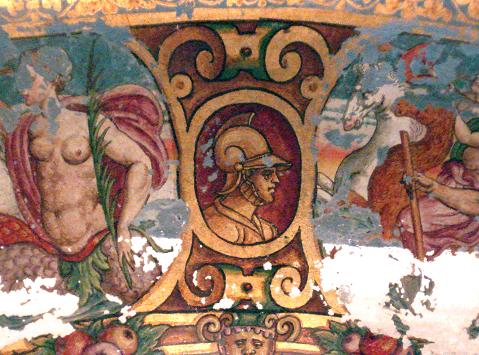Storia del vetro di Murano
Due importanti inventari muranesi del CinquecentoTwo important Muranese inventories from the 16th century

Tra le carte dei PodestÓ di Murano ci sono due inventari di fornaci muranesi della seconda metÓ del Cinquecento che forniscono interessanti informazioni sulla produzione vetraria a quei tempi. Molti prodotti erano destinati al mercato tedesco: bicchieri e piatti con stemmi o aquile smaltati a caldo, reliquiari, piatti quadretti decorati a freddo, oggetti incisi a punta di diamante. C'erano anche i prodotti per i mercati orientali, con i loro nomi caratteristici: "mastrapani", "catramessi", "soltanie". E c'erano "catenelle fatte a lume", esempi di un genere di lavorazione di cui si hanno documenti a Venezia proprio a partire dai tre quarti del Cinquecento.Erano probabilmente come una catena conservata al Kunsthistorisches Museum di Vienna che faceva parte della collezione dell'Arciduca Ferdinando nel castello di Ambras a Innsbruck ed Ŕ attribuita ai vetrai di Innsbruck, ma, come tanti vetri soffiati a cui si assegna la stessa provenienza, si pu˛ sospettare che sia stata fatta a Venezia

Among the documents belonging to Murano's PodestÓ, there are two inventories from Murano glass factories from the second half of the 16th century, which provide interesting information on the production of glass at that time. Several products were destined for the German market, including beakers and dishes with armorial bearings or pictures of eagles painted in enamel colours, as well as reliquaries, various dishes with diamond-engraved decorations, etc. Other products destined for the Eastern market were also reported with their particular names "mastrapani", "catramessi", "soltanie".
Small chains produced by lampworking are also mentioned. These are examples of glass works whose earliest documents date back to the end of the 16t century. These objects - like a chain preserved at the Kunsthistorisches Museum of Wien, belonging to the Archduke Ferdinand in Ambras Castle, Innsbruck - were often attribuited to Innsbruck glass-makers, but they had probably been made in Murano



Paolo Zecchin Via Cappuccina 13 Mestre Venezia
Two important Muranese inventories from the 16th century

Tra le carte dei PodestÓ di Murano ci sono due inventari di fornaci muranesi della seconda metÓ del Cinquecento che forniscono interessanti informazioni sulla produzione vetraria a quei tempi. Molti prodotti erano destinati al mercato tedesco: bicchieri e piatti con stemmi o aquile smaltati a caldo, reliquiari, piatti quadretti decorati a freddo, oggetti incisi a punta di diamante. C'erano anche i prodotti per i mercati orientali, con i loro nomi caratteristici: "mastrapani", "catramessi", "soltanie". E c'erano "catenelle fatte a lume", esempi di un genere di lavorazione di cui si hanno documenti a Venezia proprio a partire dai tre quarti del Cinquecento.Erano probabilmente come una catena conservata al Kunsthistorisches Museum di Vienna che faceva parte della collezione dell'Arciduca Ferdinando nel castello di Ambras a Innsbruck ed Ŕ attribuita ai vetrai di Innsbruck, ma, come tanti vetri soffiati a cui si assegna la stessa provenienza, si pu˛ sospettare che sia stata fatta a Venezia

Among the documents belonging to Murano's PodestÓ, there are two inventories from Murano glass factories from the second half of the 16th century, which provide interesting information on the production of glass at that time. Several products were destined for the German market, including beakers and dishes with armorial bearings or pictures of eagles painted in enamel colours, as well as reliquaries, various dishes with diamond-engraved decorations, etc. Other products destined for the Eastern market were also reported with their particular names "mastrapani", "catramessi", "soltanie".
Small chains produced by lampworking are also mentioned. These are examples of glass works whose earliest documents date back to the end of the 16t century. These objects - like a chain preserved at the Kunsthistorisches Museum of Wien, belonging to the Archduke Ferdinand in Ambras Castle, Innsbruck - were often attribuited to Innsbruck glass-makers, but they had probably been made in Murano
